Physical Address
304 North Cardinal St.
Dorchester Center, MA 02124
Biliary dilatation can occur as a result of biliary obstruction, from an altered functional state (e.g., after cholecystectomy or with sphincter of Oddi dysfunction), or uncommonly as a result of a choledochal cyst. The role of imaging is to identify a bile duct obstruction and define its level and cause. The cause may be intraluminal, mural, or extrinsic ( Figure 52-1 ). Cholangiographic and cross-sectional modalities provide complementary information, and both are required to investigate biliary dilatation.
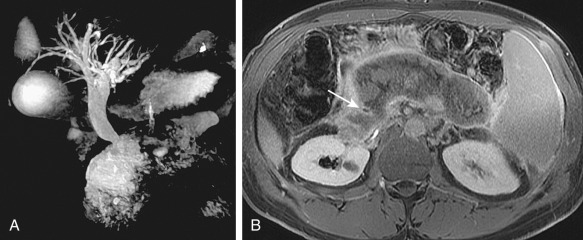
The pattern of biliary dilatation depends on the cause and level of abnormality within the biliary tree. The biliary tract may be involved diffusely or focally, or dilatation may be multifocal. Adenocarcinoma of the pancreatic head or a stone in the distal common bile duct (CBD) results in generalized intrahepatic and extrahepatic bile duct dilatation to the level of obstruction. Peripheral cholangiocarcinoma may cause segmental dilatation of the intrahepatic bile ducts. Sclerosing cholangitis and Caroli's disease typically cause multifocal dilatation of intrahepatic bile ducts.
There are numerous causes of benign and malignant bile duct dilatation. Benign causes include the following:
Choledocholithiasis: Stones in the bile ducts or cystic duct (Mirizzi's syndrome)
Benign stricture resulting from:
Previous surgery (e.g., cholecystectomy), trauma, instrumentation, or irradiation
Inflammation: Primary sclerosing cholangitis (PSC), pancreatitis, previous passage of a stone, or previous perforated duodenal ulcer; and infection
Miscellaneous: Crohn's disease, cystic fibrosis with liver involvement, and eosinophilic cholecystitis
Extrinsic compression: Liver cyst, aneurysm ( Figure 52-2 )
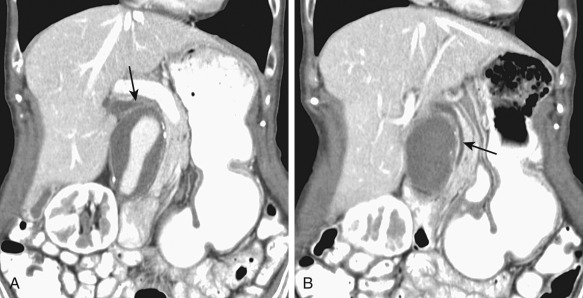
Benign neoplasms: Biliary cystadenoma ( Figure 52-3 ), ampullary adenoma, intraductal papillary mucinous adenoma of the bile ducts

Congenital anomaly: Choledochal cyst ( Figure 52-4 ), Caroli's disease
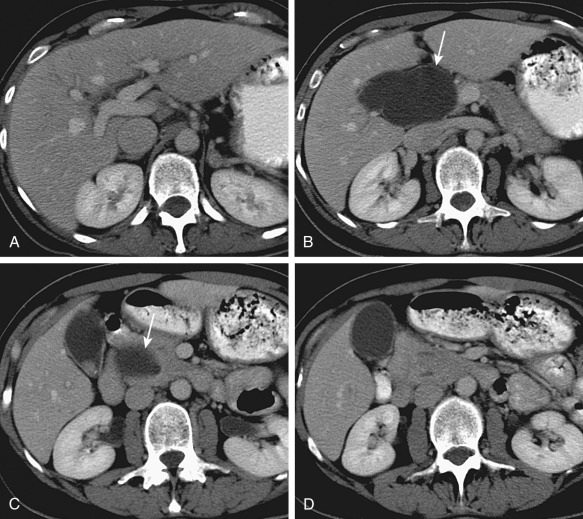
Malignant causes of bile duct dilatation include the following:
Pancreatic head carcinoma
Cholangiocarcinoma
Ampullary carcinoma
Gallbladder carcinoma
Hepatocellular carcinoma
Malignant mucinous neoplasm of the pancreas or bile duct
Lymphoma ( Figure 52-5 )
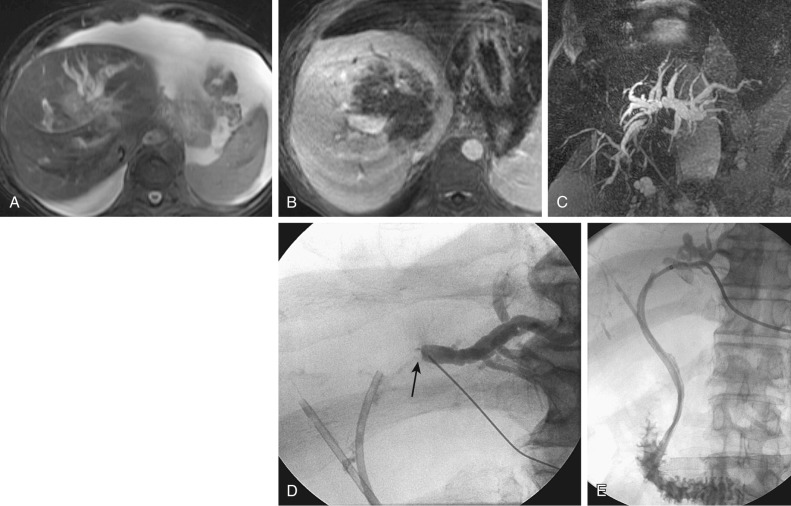
Metastatic disease
In this chapter, we discuss an approach to biliary dilatation, emphasizing the distinguishing features of benign and malignant causes. We describe some common benign causes of bile duct dilatation. Malignant and benign neoplasms that can cause bile duct dilatation and choledochal cysts are discussed separately.
Bile duct dilatation can be arbitrarily defined as a common duct diameter greater than 6 mm and an intrahepatic duct diameter greater than 3 mm ( Figure 52-6 ). There is some increase in size of the normal extrahepatic duct with increasing age.

The most common cause of benign biliary dilatation is choledocholithiasis. In Western society, cholesterol stones are the most common type; in Southeast Asia, pigment stones are more common. Parasitic infection of the bile ducts is endemic in Southeast Asia. This precipitates hepatolithiasis and can be complicated by recurrent pyogenic cholangitis.
The exact prevalence of iatrogenic biliary stricture is unclear. Bile duct injury complicates 3 to 7 per 1000 laparoscopic cholecystectomies. Biliary stricture is the most common late complication of hepatobiliary surgery.
The most common malignant cause of bile duct dilatation is pancreatic adenocarcinoma, followed by cholangiocarcinoma. Seventy percent of pancreatic adenocarcinomas involve the head of the pancreas, where they may cause CBD dilatation in addition to pancreatic duct dilatation. The incidence of cholangiocarcinoma is at least four times less than pancreatic carcinoma. Cholangiocarcinoma complicates several benign diseases of the bile ducts, including choledochal cysts, PSC, and parasitic liver infestation. Thus, malignant and benign causes of biliary dilatation may coexist and differentiating one from the other may be problematic.
All causes of bile duct dilatation lead to cholestatic symptoms once obstruction becomes severe enough. The classic symptoms and signs are jaundice, pruritus, pale stools, and dark urine. Typically, choledocholithiasis is associated with acute intermittent right upper quadrant pain and transient jaundice. Malignant causes of bile duct obstruction, such as carcinoma of the head of the pancreas, are often initially painless or manifest as dull pain, and jaundice is progressive. Occasionally, patients with bile duct strictures may develop manifestations of chronic cholestasis: xanthomas, anorexia, nausea, vomiting, weight loss, and deficiencies of calcium and fat-soluble vitamins.
Patients with biliary obstruction typically have elevated serum alkaline phosphatase and gamma-glutamyl transpeptidase levels. These enzymes are disproportionately elevated compared with serum transaminases. In more severe cases of biliary obstruction, total and conjugated bilirubin values are increased.
Patients with elevated levels of alkaline phosphatase and direct hyperbilirubinemia without biliary dilatation have intrahepatic cholestasis with blockage of biliary capillaries as a result of hepatocyte swelling.
Complete or partial bile duct obstruction leads to bile stasis. This can be complicated by ascending cholangitis and stone formation. Ascending cholangitis can be recurrent and life-threatening: the classic clinical manifestation is fever and rigors, jaundice, and right upper quadrant abdominal pain (Charcot's triad). Patients also may have altered mental status and hypotension (Reynolds' pentad). Benign causes of bile duct obstruction are more likely to cause ascending cholangitis than malignant causes.
Certain variants in bile duct anatomy, particularly around the gallbladder fossa, may lead to inadvertent bile duct injury and subsequent bile duct dilatation. The right posterior duct is frequently aberrant. It may drain via the cystic duct, and if this is not recognized at the time of cholecystectomy, bile leak and obstruction can occur.
The anatomy of the junction of the distal CBD and main pancreatic duct is slightly variable. In 60% of cases there is a true common channel at the ampulla of Vater. In 38% of cases there is a “double-barreled” opening at the apex of the papilla. In 2% there are separate duodenal openings for the two canals. Diseases that cause both bile and pancreatic duct dilatation either involve the common channel (e.g., ampullary carcinoma) or are large enough to involve both ducts (e.g., pancreatic carcinoma). Lesions that arise from the wall of bile duct (e.g., cholangiocarcinoma) or are eccentric to the common channel (e.g., duodenal carcinoma) are more likely to manifest as bile duct dilatation without pancreatic duct dilatation. Pancreas divisum or a residual duct of Santorini to the minor papilla may spare the pancreatic duct from dilatation by some periampullary lesions.
The pathogenic basis of bile duct dilatation varies. Choledocholithiasis usually is due to bile stasis and supersaturation of one of the constituents of bile. Benign bile duct strictures are often precipitated by an injurious agent that incites an inflammatory response, which is followed by fibrosis. Ischemia plays a role in the development of some strictures (e.g., after liver transplantation [ Figure 52-7 ]), and some strictures are idiopathic (e.g., PSC).
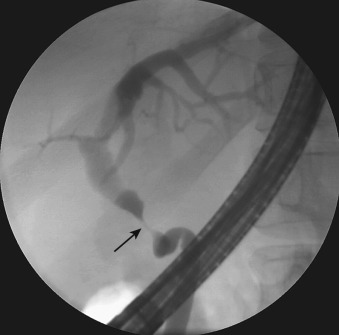
Choledochal cysts are congenital anomalies secondary to an intrinsic weakness in the wall of the bile ducts. Caroli's disease is an autosomal recessive inherited condition in which there is abnormal embryologic remodeling of bile ducts.
The role of imaging is to establish the presence of biliary dilatation and determine the level and cause of obstruction. Associated dilatation of the pancreatic duct and gallbladder are noted. Stones, masses, and strictures are searched for, as well as complications of these diseases: cholangitis, pancreatitis, stones, cirrhosis, liver abscess, and cholangiocarcinoma. If a malignant cause is found, suitability for resection is determined and staging is performed.
Of all imaging modalities, endoscopic retrograde cholangiography (ERC) and percutaneous transhepatic cholangiography (PTC) can evaluate the bile ducts with the highest spatial resolution. They are, therefore, the gold standard for detecting stones, evaluating strictures, and localizing bile duct leaks. When the bile ducts are obstructed, the ducts closest to the site of injection are best demonstrated. ERC best evaluates the pancreaticobiliary junction and distal ducts, and PTC best evaluates the proximal intrahepatic ducts (see Figure 52-5 ). Two additional advantages of ERC are that the ampulla of Vater can be directly visualized and manometry can be performed. A potential pitfall of ERC is failure to recognize complete obstruction of a lobar or segmental bile duct. In this scenario, the obstructed ducts are absent from the cholangiogram because they are not opacified, and this absence may be difficult to appreciate, with the remaining ducts seeming complete.
ERC and PTC have a therapeutic as well as a diagnostic role. Removal of stones and sphincterotomy can be performed via ERC, external or internal-external drainage catheters can be inserted during PTC, and biliary dilation and insertion of stents can be performed by both approaches.
Endoscopic retrograde cholangiopancreatography (ERCP) has a complication rate of 1% to 5%. Moderate to severe pancreatitis is seen in 0.7%; the mortality rate associated with the procedure is approximately 0.2%.
Complications of PTC include cholangitis, sepsis, hemobilia, hemorrhage, and bile leak. The reported complication rate for PTC is approximately 2%. When percutaneous biliary drainage is performed, the complication rate rises to 5% to 7%. Factors that increase the likelihood of complications include poor preprocedure clinical status, coagulopathy, cholangitis, stones, and malignant, proximal, and multiple duct obstruction.
Cholangiography is highly sensitive for detecting bile duct stones and strictures. Stones are typically smooth filling defects. Other less common intraluminal filling defects include neoplasms (which can appear papillary, irregular, or smooth and demonstrate attachment to the bile duct wall), hemorrhage, sludge, and infected debris ( Figure 52-8 ).
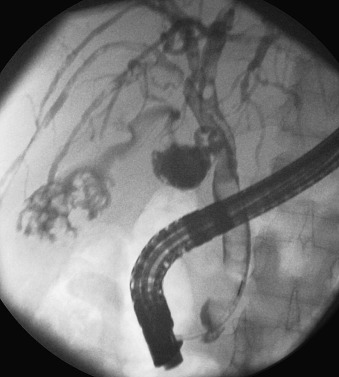
Strictures may be due to a pathologic process of the bile duct wall and/or surrounding tissues. The cholangiogram should be interpreted in conjunction with cross-sectional imaging, because this provides complementary information, in particular, identification of a mass.
The classic cholangiographic features of a malignant stricture are irregular contour, abrupt transition (>1 cm), shouldered margins, asymmetry, and associated irregular or papillary intraluminal filling defects ( Figure 52-9 ). Benign strictures classically have a long transition and are smooth, gently tapered, and concentric ( Figure 52-10 ). Unfortunately, biliary strictures often are not classic in their appearance and the specificity of cholangiography for differentiating between benign and malignant disease is poor.
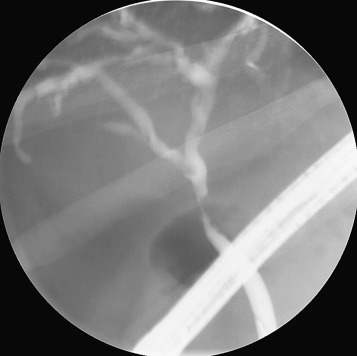
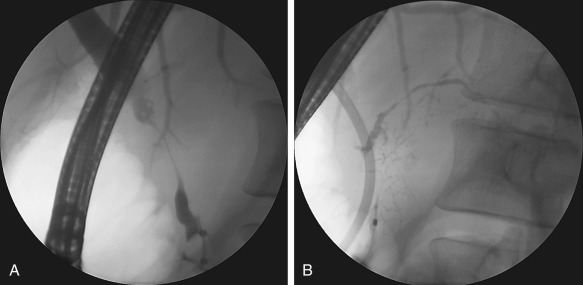
Multidetector computed tomography (MDCT) with intravenous contrast can produce high spatial resolution, with multiphase images that accurately assess the presence of biliary dilatation and detect and evaluate obstructing masses. The sensitivity of both CT and magnetic resonance imaging (MRI) for detection of pancreatic carcinoma is improved by scanning in the pancreatic phase. The pancreatic phase improves tumor conspicuity, maximizes the tumor-to-pancreas attenuation difference, and permits adequate arterial and mesenteric venous opacification for characterization of vascular invasion. The high spatial resolution of CT is particularly useful for local staging of malignancies such as pancreatic adenocarcinoma and cholangiocarcinoma ( Figure 52-11 ). CT or MRI can detect features that suggest a tumor is not suitable for resection; in cholangiocarcinoma, for example, these include hepatic parenchymal invasion; involvement of second-order bile duct branches in both lobes of the liver; vascular invasion or encasement of the proper hepatic artery, both right and left hepatic arteries, or main portal vein; extensive regional lymphadenopathy; and distant metastases.
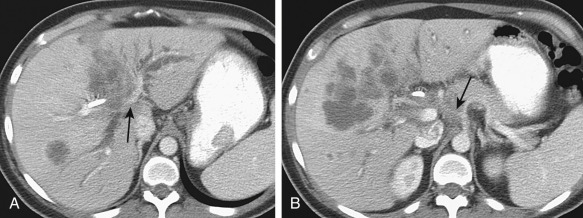
CT without cholangiographic contrast is less sensitive than MRI for detection of choledocholithiasis. CT cholangiography using iodinated contrast agents such as intravenous meglumine iotroxate (which is taken up by the liver and excreted in bile) depicts bile duct stones more accurately. In one study, the sensitivity and specificity of CT cholangiography for detecting choledocholithiasis were, respectively, 87% and 96%, compared with 80% and 88% for magnetic resonance cholangiopancreatography (MRCP). However, several characteristics of cholangiographic contrast agents have limited their use: their biliary excretion is diminished in patients with elevated bilirubin levels or liver insufficiency, they can worsen renal impairment, and have a higher rate of adverse reactions compared with other iodinated contrast agents.
Dual-energy CT (DECT), an innovation that allows concurrent scanning with x-ray beams of different energies, is being explored for improved detection and characterization of pancreatic cancer. Virtual monoenergetic CT images and iodine-specific images generated after DECT acquisition have been shown to improve the conspicuity of isoattenuating pancreatic masses and depict small tumors that are difficult to identify on single-energy (120 kVp) CT images.
MRI, including MRCP, is extremely accurate in identifying the presence and level of biliary obstruction. It has a sensitivity of 92% for diagnosing stones and 88% for detecting malignant obstruction (with >90% specificity in each case).
MRCP does not require exogenous contrast agents. It uses heavily T2-weighted sequences to image bile and pancreatic secretions within their ducts. The most common sequences used are a multiple-section three-dimensional fast spin echo sequence with respiratory triggering and a single-section (thick slab) half-Fourier rapid acquisition with relaxation enhancement (RARE) sequence performed during a single breath-hold. Multiple-section acquisitions are usually postprocessed and displayed as maximum intensity projection (MIP), multiplanar reformatted images. These postprocessed images provide a useful overview of the pattern of biliary dilatation on one image. However, they may obscure small filling defects that are apparent on the thin-section source images ( Figure 52-12 ). Therefore, both source and postprocessed images should be reviewed. In addition, fluid within bowel can obscure the bile and pancreatic ducts on MIP and thick slab images, but this is rarely a problem on thin-section source images.
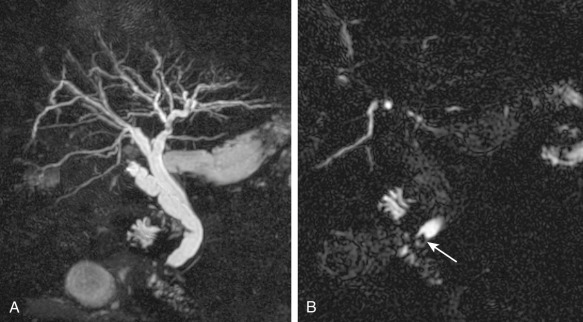
MRCP allows visualization of the bile ducts above and below the point of obstruction, a potential advantage over techniques using contrast (ERC and PTC). MRI is the most sensitive modality for the detection of a mass causing bile duct obstruction, owing to its superior contrast and temporal resolution. For instance, pancreatic adenocarcinoma is usually T1 hypointense, and fat-saturated T1-weighted images have been shown to improve its conspicuity. Pancreatic carcinoma is often well visualized as a hypointense mass in pancreatic phase postcontrast images, because it tends to be less vascular than normal glandular tissue and this phase provides superior tumor-to-gland attenuation difference ( Figure 52-13 ). Cholangiocarcinoma also may be hypointense on T-weighted imaging but characteristically shows delayed enhancement (at 1 to 5 minutes) because of intratumoral fibrosis, a feature that may be seen on MRI or CT ( Figure 52-14 ).
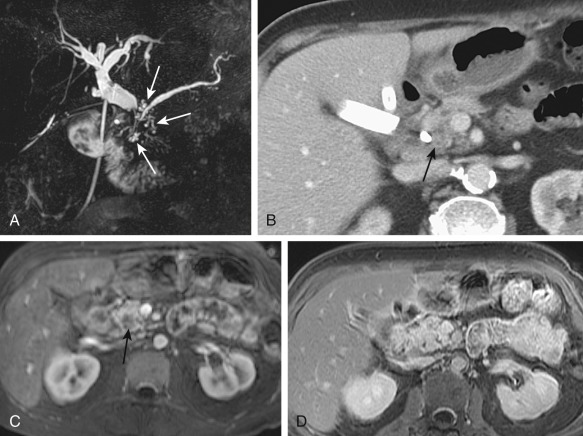
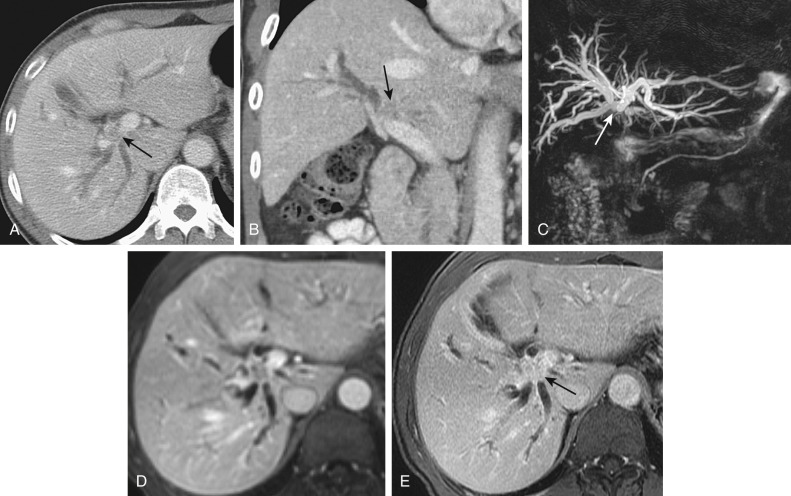
Depiction of the contour of strictures by MRCP is inferior to that with ERCP because MRCP has poorer spatial resolution.
The ampulla may be difficult to assess on MRCP for a variety of reasons, including interference from adjacent intraluminal gas, duodenal diverticula, duodenal wall contractions, and nondistention of the duodenal lumen. ERCP and endoscopic ultrasonography may image the distal CBD with greater resolution and accuracy.
Transabdominal ultrasonography is often the initial imaging investigation for evaluating clinically suspected bile duct obstruction. It is readily available and sensitive for detecting biliary dilatation, gallbladder stones, and cholecystitis. It does not require contrast agents or prolonged patient immobility ( Figure 52-15 ). Overall, it is not as reliable as other modalities for determining the cause and level of bile duct obstruction. The main technical limitation is that bowel gas often obscures the distal CBD ( Figure 52-16 ).
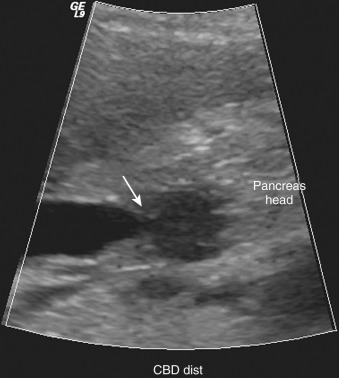
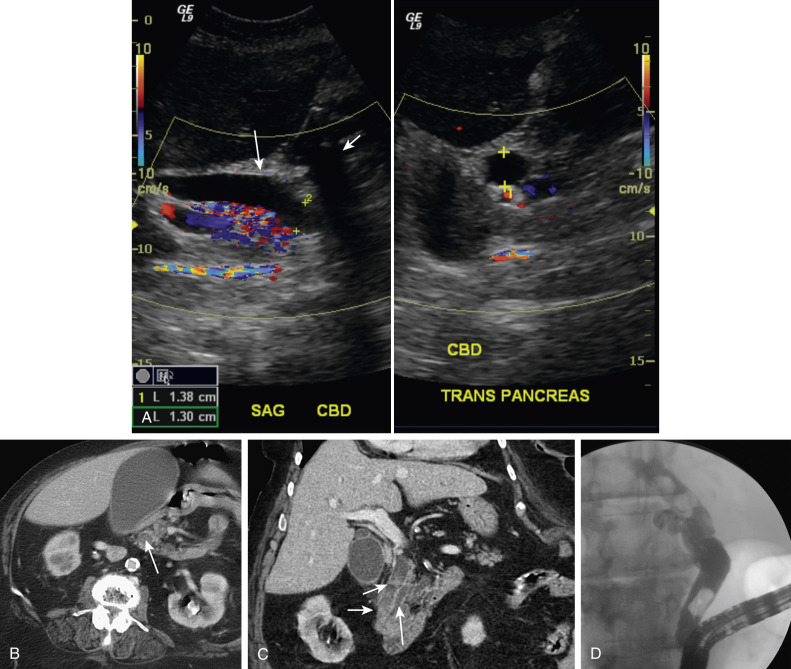
The sensitivity for detecting Klatskin's tumors by ultrasound is highly variable, ranging from 21% to 96%, and appears highly dependent on operator experience and expertise. Ultrasonography using microbubble intravenous contrast material has been reported to improve detection and staging of malignant hilar masses compared with routine ultrasonography.
Endoscopic ultrasonography with fine-needle aspiration cytology can be useful for differentiating benign and malignant causes of bile duct obstruction at the level of the biliary confluence and in the head of the pancreas.
Hepatic iminodiacetic acid scan (HIDA) can help determine the clearance of bile across a stricture or surgical anastomosis, thus providing a functional assessment of the severity of bile duct narrowing with upstream dilatation. Complete biliary obstruction is suggested if the small intestine is not visualized in 60 minutes. HIDA scans do not show biliary dilatation or the site and cause of bile duct obstruction.
The role of positron emission tomography with CT (PET/CT) in the workup of patients with biliary obstruction is still evolving as evidence of its accuracy with different tumors accumulates.
PET/CT has a role in staging of patients with malignant causes of bile duct obstruction. In assessing cholangiocarcinoma, for instance, PET/CT is more accurate than CT alone for diagnosing regional lymph node metastases and distant metastases. However, PET/CT does not appear to be more accurate at diagnosing the primary tumor than CT and MRI/MRCP.
It is unclear whether certain types of cholangiocarcinoma are more likely to be PET negative; some studies have found PET to be less helpful in infiltrating-type cholangiocarcinoma, whereas others have found no significant difference in PET detection of mass-forming, periductal-infiltrating, and intraductal types. For cholangiocarcinoma that is shown to be PET positive, PET/CT is useful for detecting metastatic and recurrent disease and assessing response to treatment.
In the setting of PSC, PET/CT may play a role in differentiating between benign and malignant strictures.
Because of its availability, relatively low cost, lack of ionizing radiation, and high sensitivity for detecting bile duct dilatation, ultrasonography is the initial investigation for obstructive jaundice ( Table 52-1 ). If bile duct dilatation is present and choledocholithiasis is detected, the patient will usually have an ERC for confirmation of the diagnosis and stone removal. If there is biliary dilatation without a clear cause or with a mass or stricture, CT or, preferably, MRI/MRCP is performed. Subsequently, ERC may be performed to remove stones, further evaluate a stricture, or place a stent across a narrowed duct. PTC is usually performed after failed ERCP.
“Tram track” appearance: Describes intrahepatic bile duct dilatation on ultrasonography—parallel echogenic lines of the dilated bile duct and adjacent portal vein branch are seen coursing through the liver.
“Double duct” sign: Refers to dilatation of both the CBD and main pancreatic duct. This is classically seen in pancreatic adenocarcinoma (62%) but also can be seen in ampullary carcinoma (52%) and chronic pancreatitis.
“Target” sign: Describes the appearance of a stone within a bile duct, surrounded by a rim of hypodense bile. A slightly eccentrically positioned stone may give rise to a “crescent” sign .
“Central dot” sign of Caroli's disease: The central enhancing fibrovascular bundle containing a portal vein surrounded by a focally dilated intrahepatic bile duct cyst.
| Modality | Accuracy | Limitations | Pitfalls |
|---|---|---|---|
| Radiography (ERC and PTC) | High spatial resolution Gold standard for choledocholithiasis and strictures Cytology sampling can be performed during ERC. Potential for therapy (e.g., stent placement) |
Ionizing radiation Invasive Potential complications: Pancreatitis, cholangitis, bile duct leak, hemorrhage Ducts beyond the point of obstruction may be poorly visualized. |
Failure to recognize complete obstruction of a lobar or segmental bile duct |
| CT | Moderately accurate for detection of stones and masses and staging of malignancy Choledocholithiasis: CT without contrast: 70% sensitivity CT cholangiogram: 90% sensitivity, >90% specificity Assessment of resectability of cholangiocarcinoma is 60%-75%. |
Cholangiographic contrast agents may worsen renal impairment and cause adverse reactions. Biliary excretion is decreased with elevated bilirubin levels and liver insufficiency. Fibrosis or inflammation may be indistinguishable from malignancy. |
Stones isodense to surrounding bile or tissue may not be detected. Local staging of malignancy is incorrect owing to inability to differentiate tumor from fibrosis/inflammation. |
| MRI/MRCP | After ERC, MRI/MRCP is the most accurate modality for detection of stones and strictures. Choledocholithiasis: >90% sensitivity, >90% specificity. Most accurate test for detecting masses Detection of malignant obstruction: >80% sensitivity, >90% specificity |
Less availability Claustrophobia Inferior spatial resolution compared with conventional cholangiography |
Surgical material (e.g., metallic clips and stents) and biliary gas (e.g., after biliary-enteric anastomosis) may cause artifacts and may create difficulties with interpretation. Intraductal air may mimic stones in the coronal plane: Axial scans demonstrate nondependent positioning of air. |
| Transabdominal ultrasonography | Choledocholithiasis: 22%-75% sensitivity | Bowel gas often obscures the distal common bile duct. | |
| Nuclear medicine | Hepatic iminodiacetic acid scan (HIDA) provides functional assessment of the severity of bile duct stricture. | Does not demonstrate the site or cause of bile duct obstruction | |
| PET/CT | Evolving role. Improves staging of malignant bile duct obstruction In cholangiocarcinoma, more accurate than CT alone for diagnosing regional lymph node and distant metastases |
Cholangiocarcinoma: Unclear whether PET/CT improves accuracy of diagnosing the primary tumor over CT and MRI/MRCP |
Considerable overlap exists between the symptoms associated with benign and malignant causes of obstructive jaundice. Progressive painless jaundice in an older patient with weight loss is suggestive of malignancy. Jaundice with a palpable enlarged gallbladder usually is not due to stones (Courvoisier's law) and is therefore also suggestive of malignancy ( Figure 52-17 ). Younger patients with intermittent sharp pain are more likely to have a benign cause of biliary dilatation.
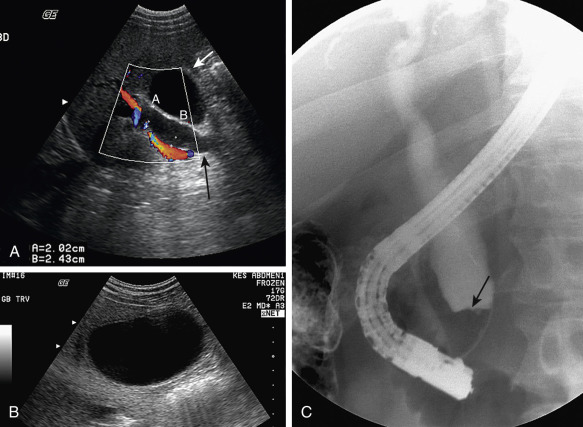
The differential diagnosis of biliary dilatation depends on the level of obstruction, unifocality or multifocality, and the presence of a stone, stricture, or mass.
Bile duct dilatation to the level of the ampulla of Vater is one pattern of dilatation that has a wide differential diagnosis. When no mass is seen, the differential diagnosis includes ampullary carcinoma or adenoma, inflammatory or fibrotic ampullary stenosis, dysfunction of the sphincter of Oddi, and an impacted or recently passed stone. The presence of a mass is suggestive of a periampullary neoplasm—carcinoma of the ampulla, pancreas, bile duct, or duodenum. MRI and ERCP are the most useful modalities for assessing ampullary obstruction. MRI may detect very small parenchymal tumors and show their relation to the pancreatic and bile ducts. If pancreatic side-branch dilatation is seen in the setting of a “double duct” sign, this is highly suggestive of pancreatic adenocarcinoma. In cases in which the degree of duct dilatation is of indeterminant significance, dynamic, time-resolved MRCP can be performed after pharmacologic stimulation of the pancreas with secretin. This provides a functional assessment in which significant obstruction at the ampulla leads to prolonged and exaggerated pancreatic dilatation. ERCP allows direct visualization of the ampulla, biopsy of a lesion, manometry, and endoscopic ultrasonography.
Another pattern of biliary dilatation—intrahepatic segmental dilatation—has a vastly different differential diagnosis. It may be caused by a mass such as peripheral cholangiocarcinoma, in which case the bile ducts tend to be irregular, distorted, and slightly enlarged. Marked multifocal saccular or fusiform dilatation of the intrahepatic bile ducts is seen in Caroli's disease ( Figure 52-18 ). Recurrent pyogenic cholangitis shares many of the features of Caroli's disease—marked bile duct dilatation, strictures, stones, and superimposed cholangiocarcinoma; however, the biliary dilatation of recurrent pyogenic cholangitis is rarely saccular ( Figure 52-19 ). Segmental intrahepatic bile duct dilatation can also be seen in PSC. However, in this disease the dilatation tends to be mild and fusiform, with the predominant feature being bile duct stricture ( Figure 52-20 ).
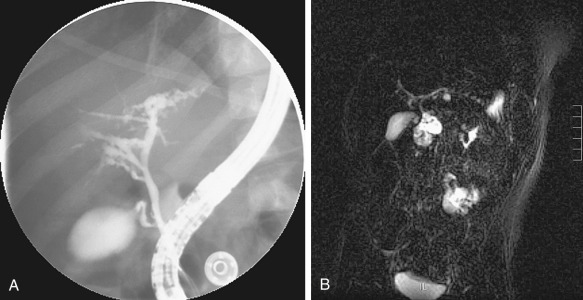

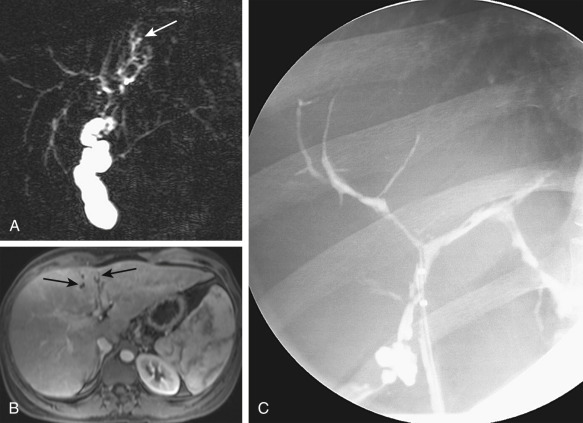
Treatment options and prognosis of neoplasms and choledochal cysts are discussed in other chapters. In general, for pancreatic adenocarcinoma and cholangiocarcinoma, surgical resection with negative resection margins is the only chance for cure. Adjuvant radiation therapy and chemotherapy have not been shown to improve survival in cholangiocarcinoma. Options for palliation include biliary drainage procedures, radiation, chemotherapy, and photodynamic therapy.
Is bile duct dilatation present?
What is the level of obstruction and what is the cause? Is there a stone, stricture, or mass?
Are there complications of bile duct obstruction (e.g., hepatic abscess, biloma, ascending cholangitis, cholangiocarcinoma)?
If a malignant cause is found, staging should be performed to determine if the patient is a surgical candidate or needs medical therapy alone.
The formation of gallstones is due to bile stasis and supersaturation of solutes, such as cholesterol and bilirubin.
Choledocholithiasis can be due to stones formed within the bile ducts (primary) or within the gallbladder, subsequently migrating to the bile ducts (secondary). Primary choledocholithiasis is usually secondary to an underlying ductal abnormality such as biliary stricture or choledochal cyst.
In the developed world, most stones are cholesterol stones. These are more common in females and with increased dietary fat intake. In underdeveloped parts of Southeast Asia, brown pigment stones are more common, and these are formed in chronically infected bile ducts.
Become a Clinical Tree membership for Full access and enjoy Unlimited articles
If you are a member. Log in here